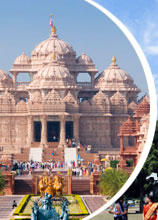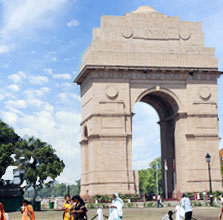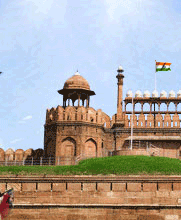 Delhi
mosques include the renowned Jama Masjid, one of the largest and the
most graceful mosques in India. Apart from that also, there are a number
of mosques in Delhi, India catering to the needs of the Muslim
population living in the city. Some of these mosques are worth visiting.
Given below is a list of some of the famous Mosques and Dargahs of New
Delhi and other areas of the city:
Delhi
mosques include the renowned Jama Masjid, one of the largest and the
most graceful mosques in India. Apart from that also, there are a number
of mosques in Delhi, India catering to the needs of the Muslim
population living in the city. Some of these mosques are worth visiting.
Given below is a list of some of the famous Mosques and Dargahs of New
Delhi and other areas of the city:Jama Masjid Delhi
Jama Masjid is one of the largest mosques in India, also known by the name of "Masjid-i-Jahan Numa" (visible to the world). Situated near the Red Fort in Delhi, it is one of the last monuments built by Mughal emperor Shah Jahan. Designed as Shah Jahan's primary mosque, Jamma Masjid of Delhi is built in red sandstone, with an extensive use of white marble. The interiors of the mosque are inlaid with stripes of black. It took six years to complete this simple yet elegant monument. Delhi Jama Masjid was built on a high platform so as to make it visible from all the neighboring areas.
Dargah of Nizamuddin Auliya
Nizamuddin Dargah enshrines Hazrat Nizamuddin Auliya or Nizam-ud-Din, a revered Sufi saint. During the lifetime of the saint, a settlement developed here, still inhabited and known by the name of Nizamuddin. Hazrat Nizam-ud-Din Auliya Dargah of Delhi also entombs Amir Khusrau, a poet and the saint's favorite disciple. The Dargah was built by Muhammad Tughluq and consists of one of the most revered pilgrimages of the Muslims. Other tombs enshrined in the Delhi Hazrat Nizamuddin Awliya Dargah are those of Jahan Ara Begum, Shah Jahan's daughter and Mirza Ghalib, a distinguished poet.
Chiragh-I-Delhi Dargah
Chiragh-I-Delhi Dargah is situated in the village of Chiragh-Delhi. This township grew up around the Dargah slowly and gradually. Chiragh-I-Delhi Dargah entombs Nasir-ud-Din Mahmud, also known as "Raushan Chiragh-i-Dili" (illuminated lamp of Delhi). A disciple of Hazrat Nizam-ud-Din, he also succeeded the Hazrat as the head of the Chishti sect. A twelve-pillared square chamber, enclosed within perforated screens consists of the tomb of Nasir-ud-Din Mahmud. The chamber has four small domed towers at the corners and is surmounted by a plastered dome rising from an octagonal drum.
Moth Ki Masjid
Moth ki Masjid, also known as "the mosque from Lentil" now lies deserted and secluded. This mosque was built during the rule of Sikandar Lodi around 500 years ago and has a legend attached to its origin. It is believed that one day Sikandar Lodi gave a grain of moth (a type of lentil) to his loyal minister Wazir Miya Bhoiya as a reward, just for fun. The minister took those seeds and started planting the seeds year after year. Gradually the seeds multiplied many times and a day came when they could be sold for money, enough for the construction of a mosque.









